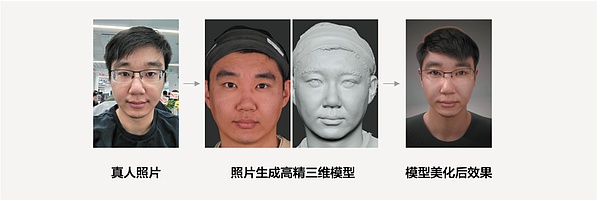Two Sides of a Digital Being: Aging in the Metaverse, Rebirth in AIGC
Digital Aging vs. Rebirth in AIGC“A virtual anchor for 29,800 yuan a year, claiming to be broadcasting 24 hours a day, earning more than ten thousand yuan a month, but in fact, cannot reply to keywords. After half a month of broadcasting, the live broadcast room was banned for violation of rules by Kuaishou, and finally there was no way to complain or get a refund.”
On April 18, 2023, after seeing the promotional video of a digital anchor on Douyin, Zhang Ming (pseudonym) placed an order with passion and used it to sell goods in his own live broadcast room. As a result, the GMV did not increase, and he himself became the number one “leek.”

Image source: Internet
- Top venture capitalists: The biggest risk of AI is not pursuing it with maximum effort
- Review of the CRV Bull-Bear Battle and Current Short-Selling Cost Evaluation
- Potential Airdrop Opportunity: Taro Testnet
On social media platforms, Zhang Ming is not alone. With just one swipe, there are many contents promoting digital humans and complaining about digital humans, and the price difference is startling. The same promotional language, virtual human templates, and virtual human customization, “8,000 yuan for customizing image,” “299 yuan for 24-hour rotation broadcasting,” “Taobao 19.9 orders for smart live broadcast digital humans,” without differentiation, and unable to determine the authenticity, the large model has brought about the “blind rush” of digital human applications, and the side effects are also very obvious.

Image source: Taobao screenshot
“Chaos, very chaotic, the water of digital humans is too deep!” Zhang Ming told Light Cone Intelligence that as a merchant facing a brand-new technology application, he cannot judge the quality of the product or the high or low price. For specific details, he can only experience them after paying. There is no reliable platform or unified standard.
According to Light Cone Intelligence’s investigation, there are not a few merchants like Zhang Ming who have demand for digital anchors and virtual anchors. Nearly 60% of users have contacted digital anchors through e-commerce platforms, and nearly 50% of them said they will use them in the future. Another merchant, Xiao Jie (pseudonym), believes that since the sales effect is similar, digital humans are definitely more cost-effective: “After seeing a post on Xiaohongshu that said ‘digital human live broadcast broke 10,000 on the first night, and I was still sleeping,’ I was immediately tempted.”
The huge market demand is driving the current digital humans to accelerate towards commercial landing, but it also brings about birth pains.
On the one hand, there are suddenly many types of digital human companies mixed together, including companies that have AI technology and provide true digital humans; there are also shell companies that sell products and applications under the name of the original factory; and there are agents and channel partners who swarm to harvest users after sensing business opportunities, which is also the core reason for the current chaos in the digital human market.
On the other hand, the emergence of large models has provided digital humans with more application scenarios, and for new scenarios, no one has any experience. The 3D digital human production process has been reshaped, and efficiency has been improved in every step from modeling to animation production. 2D digital humans have become the main characters, reducing costs in production and empowering their use. After the price was lowered, they entered a new stage of large-scale commercialization.
It can be seen that whether it is technological development or commercial landing, digital humans have entered a new cycle.
The “Second Spring” of Digital Humans
“Less than a year after its establishment, it hit the jackpot as if pies were falling from the sky.” Andrew recalled the heyday of metaverse, and immediately launched the next plan after raising funds in the first half of the year. “At that time, I felt that raising funds twice a year was definitely no problem.”
In fact, this is not the first time that digital humans have been popular. In 2020, when the metaverse was rising, virtual people such as Feng Xiaoshu, a meteorological anchor for the Winter Olympics, Cui Xiaopan, a Vanke employee, Hua Zhibing, a virtual female master of Tsinghua, Douyin’s beauty makeup expert Liu Yexi, and the first super-realistic national style KOL Ling and other virtual people constantly “went out of the circle”, and the virtual people’s track ushered in its first big outbreak.
The capital market is the barometer of the industry. Data shows that in 2021-2022, the virtual digital human track had a total of 57 financing events, and the financing amount reached 4.461 billion yuan, with a compound annual growth rate of financing amount reaching 97.71%.
However, soon, the “cooling” of the metaverse caused the virtual human track to also enter a state of stagnation. In the second month of financing, Andrew encountered the cold wave of the metaverse. Since then, there has been no financing, and he can only struggle to make a living.
“Recently, the frequency of forwarding congratulations on the financing of peers in the circle has obviously decreased. At the end of 2021 and the beginning of 2022, it could be once a week or several times a week, and the frequency has now dropped to once a month.” Another industry insider revealed.
Even large companies are not immune. ByteDance’s metaverse project “Party Island” team was disbanded and the app was taken off the shelves. Ma Jie, the creator of Baidu’s “Xilang,” abandoned Du Xiaoxiao and resigned. According to Light Cone Intelligence, Tencent’s smart video business line has also been briefly shut down. In the third quarter of 2021, Meta, Nvidia, ByteDance, Tencent, NetEase, and other big factories created the heyday of the metaverse, but in less than a year, they buried it with their own hands.
Just as life was hanging by a thread, the big model arrived and the digital human racetrack saw a resurgence.
In March, Wanxing Technology released the AIGC short video outbound marketing tool “Wanxing Playburst” for the domestic market. By inputting the copy, users can generate AIGC “real-person” marketing short videos with just one click. The AI digital human customization service has been fully launched, supporting digital human image customization, voice replication, and video template customization. At the end of the same month, Tencent launched the new AI intelligent creation assistant “Tencent Zhiying,” which released AI creation tools such as Zhiying digital humans, text dubbing, and article-to-video conversion.
On April 10th, SenseTime launched the Ruying digital human video generation platform under the “RiRiXin Large Model” system, which allows for the creation of ultra-realistic digital avatars with just one real-person material input. On May 27th, Baidu released the e-commerce AI anchor production platform and launched the Hui Bo Xing, which claims to take only 10 minutes to complete the production of a digital human live-streaming room. On June 13th, 360 launched the “360 AI Digital Human Plaza,” which includes 200+ virtual digital human characters, such as Sun Wukong, Zhuge Liang, and other digital celebrities, as well as digital employees with different functions such as marketing, operations, and programmers.
In addition to the big companies, start-ups have also learned from the experience of the metaverse and are no longer doing lofty “design,” but are instead pragmatically looking for commercialization scenarios to land on.
Xiaobing announced the launch of the “Clone Person Plan,” and the first batch of web celebrity star clone persons have already gone online. Agora Technology is stepping up its digital human business, moving from originally focusing on 3D digital humans to a 2D and 3D multi-line approach. Among them, the 2D business has launched a one-stop smart digital human solution that is applied to knowledge transmission, finance, education, marketing, and other scenarios. Yilan Technology has released digital humans mainly used for short video creation in the form of speech delivery. Mofa has launched virtual corporate business cards for enterprise promotion needs, which are used in enterprise marketing and external communication scenarios.
The capital market is once again stirring, this time expanding to the entire upstream and downstream of digital human production. May and June marked a peak in intensive financing.
-
On May 23rd, the metaverse virtual scene company Fangtang Star completed a tens of millions of yuan angel round and angel+ round financing;
-
On May 31st, the metaverse application scenario merchant “Yuanshang Technology” recently completed a tens of millions of yuan angel round financing;
-
On June 6th, the metaverse marketing company Caffeine Technology received tens of millions of yuan in Pre-A round financing;
-
On June 7th, FOCO, an AI digital human solution provider, completed tens of millions of yuan in angel round financing.
-
…
Numbers of digital anchors have flooded into short videos and live streaming, and live streaming jargon such as “Lao Tie”, “Up Link” and “Chop Hand” are commonly used. Bigwigs in the digital industry like Qian Xuesen, Zhou Hongyi, and Huang Renxun have appeared at conferences to give speeches, and digital avatars and virtual anchors are the most trendy style.
According to Qichacha, the number of companies established within the past six months that are related to digital people is close to 20,000, an increase of about 20% from the second half of last year.
Whether it is the high frequency “updates” of Internet giants and startups, the influx of hot money, or the degree of popularity in the merchant market, technological progress and demand are driving the wheel of digital people forward and opening up new situations.
Large models make digital people “alive”
Excitement may be short-lived, but the changes brought about by large models are real.
Guangcong Intelligence has combed through the production and application process of multiple digital people companies and drawn an “AI digital person industry chain” diagram. We found that AI technology has penetrated into the digital person industry chain like capillaries.

Upstream in the industry chain, in addition to traditional CG technology (computer animation) and general facility technology companies, AI companies and virtual scene construction companies have also entered the market one after another. The production of digital people is not yet mature, but a series of virtual scene companies represented by Fangtang Planet have begun to seek scenarios and construct scenarized content for digital people activities.
In the middle platform layer, there are currently two types of players. One is companies such as Baidu, Tencent, and Shangtang, which open up the BlockingaS platform capabilities to the outside world; the other is companies such as Jizhi Technology, Yilan Technology, and Mofa Technology, which provide general products and customized services.
At the application layer, companies such as Wanxing Technology provide Wenshengtu, Tushtu, and Wensheng AI digital person video services.
The 3D digital person, a relic of the metaverse era, was once left out by many companies due to the high technical threshold.
The difficulty of 3D digital person production lies in two aspects: modeling technology and interactive feedback. On the one hand, three-dimensional modeling requires a large amount of data, and also requires high precision and refinement; on the other hand, not only must the digital person be able to “move”, but also be able to talk and learn.
Now, with large models, the production process of 3D digital people has become simplified.
The product manager of the digital human-related products at SenseTime introduced the AIGC digital human production platform, which includes an intelligent generation engine for character images, an intelligent driving engine for character actions, and an intelligent interaction engine, corresponding to the modeling, animation design and production, and the ability construction for multi-modal interaction and deep learning of digital humans, respectively.

“In the painful modeling process, as long as a small number of facial scans are based on the photos, algorithms can automatically generate high-precision 3D facial models. The corresponding algorithm modules can also be called to automatically beautify and process facial and hair details of character images. In the intelligent interaction process, large models can help AI digital humans quickly establish a dialogue relationship in different scenarios and customize industry-specific digital humans,” said SenseTime.
Large models have indeed pushed 3D digital humans, but 2D digital humans are still running wild in the AIGC era.
“2D digital humans cannot raise the presentation effect from 60 to 80, but can be used by most companies first and can greatly improve efficiency, which is the key,” said Agora.
Currently, the efficiency improvement effect of 2D digital humans is significant. The product manager of the digital human-related products at SenseTime said that AI can greatly reduce the manual processing time in the traditional video production process by 90%, and the model training time by 60%. Various customized digital human training tasks can be completed within 48 hours. Dour, the business manager of Wondershare Filmora, said that the current time for the Wensheng AI digital human video is about a few minutes. With the advancement of technology, the efficiency of Wensheng videos will further improve in the future.
Using AI to generate copywriting is one of the most widely used features of 2D digital humans at this stage.
“AI digital humans complement large models. For example, users can input keywords to generate marketing copy with one click, which can further link the content creation and AI digital human video production,” said Dour.

It is reported that Wondershare Filmora’s overseas version, Wondershare Virbo, has launched a new zero-threshold AI-generated script function, bringing users a “full-link AIGC creation” experience from script writing to “real people” appearance and video automatic generation.
SenseTime’s RuYing platform also applies the ability of Wensheng Tu to digital human video production, and users can generate corresponding video materials by giving prompt words.
Live streaming with AI avatars is a feature that every company is eager to explore for profit.
According to Du Xiaobin, the person in charge of the marketing department of Agora.io, “Currently, relatively intelligent AI avatars can realize live streaming interaction. The technical principle behind this is that the enterprise needs to establish a template library or knowledge base in advance. Once the corresponding keywords are triggered during the live streaming, the AI avatar can call up the relevant content in real time for response.”
Although the task of achieving real-time interaction has been accomplished in terms of results, it is still far from having a “long brain” AI avatar.
However, Du Xiaobin stated that if the capability of ChatGPT is introduced in the future, it will be possible to achieve open real-time responses during live streaming.
“At present, the regulatory measures of AIGC are still unclear, and the industry is still in a wait-and-see attitude. After the policy is clear in the future, it is not ruled out that the compliance range of open-ended responses will be restricted through technical means.” Du Xiaobin said.
However, some investors also expressed that “at this stage, the effect is not important. In entertainment scenarios such as short videos and live streaming, the fault tolerance rate for AIGC technology itself is high, so products can be iteratively updated boldly.”
AI avatars have taken another step forward, but having just AI avatars is not enough. To use them well, matching virtual scenes is also indispensable.
In order to promote products through live streaming with AI avatars, it is necessary to have a harmonious background for AI avatars, and virtual scene conversion is also necessary to make the AI avatars move naturally. At the same time, virtual scenes themselves can be converted into content to attract users. The relationship between AI avatars and virtual scenes is complementary.

Liao Qinghui, a partner of Fangtang Planet, believes that spatialization is the future of virtual humans. “Our core product is to allow virtual humans and virtual humans, virtual humans and scenes to interact. Considering the current hardware, cost, and commercial feasibility, we don’t need to excessively pursue the refinement of virtual humans. As the user’s avatar, we are considering allowing more people to enter a space scene at the same time, so that they can interact, explore, play games, learn, and even create their own personalized space.”
Commercialization “blindly running with closed eyes”
AI avatar products have become more mature and cheaper.

According to Light Cone Intelligence, there are currently three pricing models for digital humans: membership subscription, customized pricing, and usage-based pricing.
A digital company revealed that its regular membership fee is 180 yuan, which allows users to create 40 minutes of video and generate about 100 short videos. Customized digital images are available in different grades, with the lowest grade being 8,000 yuan and a 9,998 package, which can customize appearance, sound, and action.
Du Xiaobin said: “In the past, we used real human anchors to record. The market price for ordinary anchors is 10,000 to 20,000 yuan, not including the cost of building enterprise live broadcast rooms. However, their digital humans only cost 10 to 20,000 yuan for annual customization, and the labor cost alone can help companies save about 100,000 yuan per year.”
It is reported that Wanxing Bo has also launched products and services for digital human subscription and customized models. At present, the overall price is more friendly to users. For example, in the case of subscription, using Wanxing Bo, the cost of producing a single video for users is only a few yuan.
Usage-based pricing is still under exploration and can only be implemented when the user base reaches an outbreak.
Chen Xiyan, co-founder and CTO of Yilan Technology, also said: “The main price reduction is for 2D digital humans, and the cost of 3D digital humans is still prohibitively high and requires a lot of investment. It needs to be emphasized that the steep drop in 2D digital humans does not represent the best level in the industry, but is an acceptable minimum quality. If you want better results, high costs are still unavoidable.”
After the price reduction, large-scale commercial scenarios have begun to land. At present, digital humans have begun to land in commercial, financial services, education, medical, cultural media, games, cultural tourism, automotive transportation, and government services.

Bank digital employee

Brand marketing
Chen Xiyan introduced that as a video solution provider, Yilan Technology has already combined digital human capabilities with the actual business of large customers in industries such as finance and culture and media. For example, it provides content production services for digital human financial science popularization videos for a certain bank. Compared with real people appearing on the screen in the past, it has a reasonable cost-performance ratio, fast production speed, and can ensure the safety and norms of the content.
At the same time, he revealed that “the penetration speed of digital humans in various fields is faster than imagined, and finance is only a small part of it. Compared with technology, the improvement and extension of corresponding capabilities with different industries are more challenging for a company’s service capabilities.”
Digital humans are quietly occupying overseas live broadcast rooms. According to media reports, the monthly salary of a mature anchor in Indonesia (4,000-5,000 yuan) can basically buy a customized digital human that never rests all year round, and an annual salary (50,000-60,000 yuan) can purchase an entire set of software, equivalent to a whole year without rest. This condition has attracted many cross-border e-commerce companies.
“Basically, it can break even with the cost” “How much to earn is still uncertain” “One shot, one loss” Multiple companies in the industry responded. Obviously, it is too early for any digital human company to talk about profitability.
Source code companies barely break even, and “shell companies” make a profit by drilling loopholes.
AI digital humans have genuine and fake distinctions. AI original manufacturers are true AI digital humans. Shell companies refer to fake AI digital humans.
“As soon as the product came out, many customers came directly to us and asked to use our products and technology, and they directly used them to make money.” A certain digital human company talked about its experience of being “shelled”.
Shell companies themselves do not have products, and are unwilling to lose money-making opportunities, so they turn to purchase packaged templates, without the cost of technology, service, after-sales, etc., making their profit margin far higher than source code companies.
Zego Technology questions the ability of shell companies. “Shell-making digital humans is actually based on the basic capabilities of the original factory, to package a specific product or take out a plan to sell. The price of shell-making products seems to be lower, but the functionality is less, and the customization is not flexible enough. It is just a use of an application, let alone most companies. It is difficult to use it.”
Shell companies lack “soul”, and flat templates cannot serve every industry. The scene is the key to understanding the digital human era of AIGC.
With the scene, SenseTime can break the original software and hardware integrated delivery model and turn to pure software delivery, comprehensively reducing costs; Fangtang Planet can enrich virtual people and virtual spaces. Game-like gameplay enhances interactivity and content; WPS Technology can further penetrate cross-border scenarios, and by providing AI digital human marketing short video creation services, help cross-border sellers seize the new era of overseas marketing.
Conclusion
In the first half of 2023, the commercialization of the digital human industry is still in its infancy, and the progress of commercialization varies among companies. Some products have not yet been launched, some have just started to cooperate with head companies to accumulate customized experience, and some products have entered a mature stage and are beginning to accumulate users.
Regardless of the stage, the common characteristic of these players is to give up part of the profit margin and use relatively low-priced or even free strategies to open up the market and quickly explore more application scenarios. Walking on both legs, and matching with a high-end customized route, through serving head customers to precipitate replicable industry know-how experience.
Users are the best touchstone. After being tested by the market, the competition will officially begin when the bubble gradually disappears.
We will continue to update Blocking; if you have any questions or suggestions, please contact us!
Was this article helpful?
93 out of 132 found this helpful
Related articles
- MakerDAO community initiates a vote to reduce the GUSD reserves of DAI from 500 million US dollars to 110 million US dollars.
- EigenLayer has been deployed on the Ethereum mainnet
- Building to collapse? Another South Korean cryptocurrency company suspends withdrawals
- June 2023 FOMC Meeting Notes: Rates Can Go Higher
- Deep Dive into Uniswap V4: A “Masterpiece” of Decentralized Exchange
- Analysis of Sui’s ecological data and token release status
- Exploring ERC-4626: Tokenized Vault Standard






